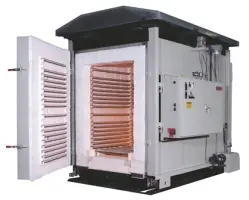Calcining Kilns Ceramics / Advanced Materials
Calcination or calcining, refers to a thermal treatment process where inorganic, non-metallic solids (i.e., minerals, ceramic powders) are heated below the melting or fusion point for thermal decomposition, phase transition or for removal of a volatile fraction, including chemically bonded water.
Typical process temperatures are between 800°C and 1300°C. Ceramic engineers define exact calcining process parameters which may include tight thermal profiles for the heating and cooling phase with strict tolerances.
A classic example of the calcining process is the heating of crushed limestone to produce quick-lime, a critical ingredient in cements and concrete. This process was known as far back as the Roman Empire, and may be even older.
Generally, calcining is used to prepare raw materials, either alone or in mixtures, for further processing or for the recovery of base materials from the scrap portions of subsequent processes. Calcining is often a critical preliminary step in the preparation of raw or precursor materials for advanced ceramics compositions.
For many materials applications, calcining continuous furnaces can be directly fuel-fired. In the case of high-purity materials, or when the product would react with the water vapor created by combustion, they are often electrically heated.
Keith Company’s calcining batch furnaces/kilns or continuous furnaces/kilns include:
Contact Keith Company to order calcining batch furnaces or kilns or calcining continuous furnaces or kilns for your application, or to learn more about any of our products.






